| Article ID | Journal | Published Year | Pages | File Type |
|---|---|---|---|---|
| 8865340 | Journal of Aerosol Science | 2018 | 8 Pages |
Abstract
Impactor is a widely used air sampling device because of it is relatively inexpensive and easy to use for sampling bioaerosols. However, sensitive microorganisms may have significant mechanical stress by inertia impaction. Therefore, this sampling method can underestimate the concentration of airborne bioaerosols. Electrostatic sampling can be a good alternative method for bioaerosol sampling because of a less stressful collection technique and has been frequently used. However, it is well known that ions and ozone generated by corona discharge can also inactivate the bioaerosols. In this study, the performance of our lab-made electrostatic rod-type sampler was compared with that of a single stage viable impactor (TE-10-880, Tisch Environmental, USA). The flow rate of our electrostatic sampler was determined so that the number of aerosols collected using the electrostatic sampler would be same as that of aerosols collected using the impactor of which flow rate was 28.3 lpm. After counting the colony numbers of bacteria captured using two different samplers, each cultured colony was identified with Matrix-Assisted Laser Desorption Ionization-Time of Flight Mass Spectrometry (MALDI-TOF MS) at indoor environment. The total number of identified bacterial genus was 17. Among 17 bacterial genuses, 15 genuses were identified when the electrostatic sampler was used while 9 genuses were identified when the impactor was used. In common, 7 genuses were detected from both samplers. 5.2 folds concentration of bacteria were cultured when the lab-made electrostatic rod-type sampler was used.
Keywords
Related Topics
Physical Sciences and Engineering
Earth and Planetary Sciences
Atmospheric Science
Authors
Hyeong Rae Kim, Ji-woon Park, Hyung Sun Kim, Dongeun Yong, Jungho Hwang,
